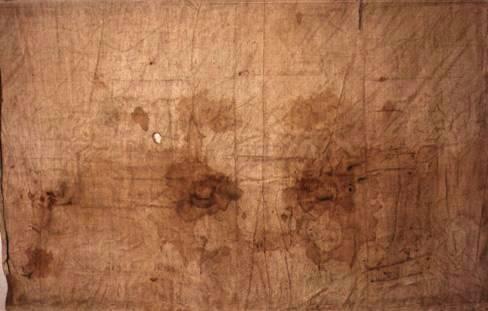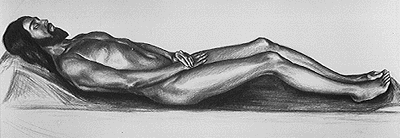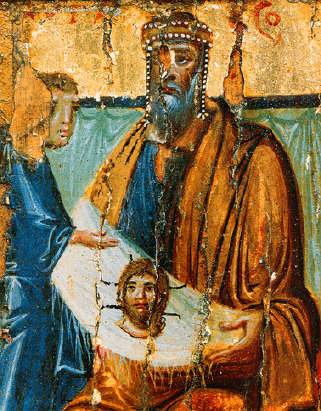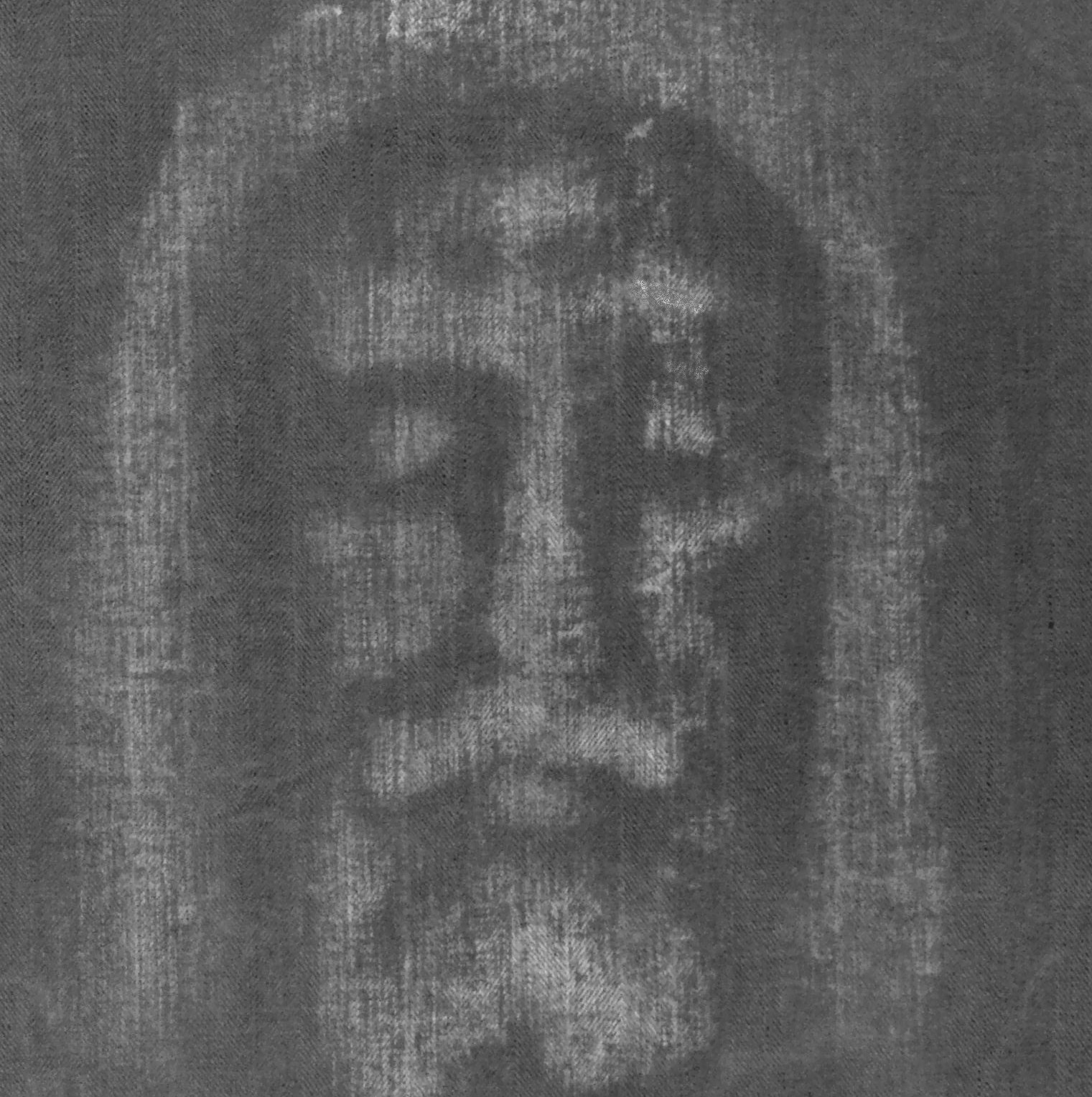Here is part 4, "The Shroud of Turin and the Sudarium of Oviedo" (2), of my critique of historian Charles Freeman's,

[Above: Perfect fit of Sudarium of Oviedo (right) to the face on the Shroud of Turin (left), in Bennett, J., "Sacred Blood, Sacred Image," 2001, plate 20. This is proof beyond reasonable doubt that the Shroud of Turin and the Sudarium of Oviedo once covered the bleeding head of the same man.]
"The Turin Shroud and the Image of Edessa: A Misguided Journey," May 24, 2012 [page 3-5]. The paper's words are bold. See previous parts 1, 2 and 3.
Having attempted to portray the Shroud of Turin as just another medieval fake relic, Freeman now attempts to do the same to Sudarium of Oviedo. That Freeman does this is tacit acknowledgment of my point in part 2 that:
"... The overwhelming majority of Shroud pro-authenticists believe that only TWO "of the thousands of ... first century ... relics [are] genuine: the Shroud of Turin and the Sudarium of Oviedo.
Freeman had previously made the patently false claim in part 1 that:
"the Turin Shroud is very much a cult of the past fifty years, not a medieval one"
He prefaces his attempt to discredit the Sudarium of Oviedo with the vacuous claim:
However, there is something about burial cloths and images that attract interest now in a way they did not in the Middle Ages.
What does Freeman mean by this? It is so vague ("burial cloths and images") that it virtually meaningless. This is the 21st century and "The Middle Ages [was] ... the period of European history encompassing the 5th to the 15th centuries" ("The Middle Ages," Wikipedia, 19 July 2012). So it goes without saying that "burial cloths and images ... attract interest now [in the 21st century] in a way they did not in the Middle Ages [5th to the 15th centuries]. So Freeman's statement, as it stands, is trivially true.
Many people have heard of the Sudarium of Oviedo (in Spain), a bloodstained cloth purporting, like the Shroud, to come from the tomb of Jesus.Indeed! Classics scholar Mark Guscin explains:
"In the cathedral town of Oviedo in the north of Spain there is a cloth measuring approximately 84 x 53 cm on which there are bloodstains, fold marks, and other things invisible to the naked eye, such as pollen, but definitely no image. What makes this cloth special is that the bloodstains are claimed to be those of Jesus. ... Such a cloth is known to have existed from the gospel of John:Simon Peter, following him, also came up, went into the tomb, saw the linen cloths lying on the ground, and also the cloth that had been over his head; this was not with the linen cloth but rolled up in a place by itself. (John 20.6-7)... John describes in detail the cloths he saw in the tomb. First he mentions the linen cloths, or as other translations of the gospel call them, the linen wrappings. The Greek word is, `ta othonia', which means `pieces of fine linen'. It is a different word from that used in the other gospels, but the meaning is the same, and the curious thing here is that the word is plural. The other gospels only refer to the one cloth in which Jesus was wrapped, whereas John mentions at least two. ... The interesting point is the other piece of material that John saw -'the cloth that had been over his head'. The word he uses is, `to soudarion', which is an adaptation of the Latin `sudarium'. This word ... means a `face cloth' or `towel', used for drying or wiping the face. John saw this cloth rolled or folded up ... separate from the other cloths. On seeing these cloths, John tells us that he believed. ... Early Christian writers ... attribute John's believing on seeing the cloths to his realisation that if the cloths were still there, the body could not have been stolen, as no robbers would have taken the time and trouble to unwrap the corpse and leave the cloths folded or wrapped up, each in its own place." (Guscin, M., "The Oviedo Cloth," 1998, pp.8-11).
As can be seen below, the Sudarium of Oviedo is so unremarkable (if not revolting!) that there would be no reason for it to have been
[Above: The Sudarium of Oviedo: Mark Guscin, "The Sudarium of Oviedo: Its History and Relationship to the Shroud of Turin," 1997]
kept in the first place, let alone treasured, unless it actually was "the cloth [Gk. soudarion] that had been over his [Jesus] head" mentioned in John 20:7. And in fact (as can be seen in the photo at the beginning of this post) when the Sudarium stains are superimposed on the Shroud, "they coincide exactly with the face of the image on the Turin Shroud":
"The most striking thing about all the stains [on the Sudarium of Oviedo] is that they coincide exactly with the face of the image on the Turin Shroud. The first fact that confirms the relationship between the two cloths is that the blood on each belongs to the same group, AB. ... The length of the nose which produced this stain has been calculated at eight centimetres, just over three inches, which is exactly the same as the length of the nose on the Shroud. ... This, however, is not the only point of coincidence between the nasal areas on the two cloths. Both of them, especially the Shroud, contain a high concentration of ground particles and dust in this area. When a man was being led to the place of crucifixion, he had to carry the horizontal bar of the cross, which was probably tied to his outstretched arms and placed across the back of his neck. This meant that whenever he fell, which would have been often after being whipped and with such a weight to carry, he could not protect his face from the impact of the fall. This also explains why this nose was swollen, slightly displaced and bleeding ... Perhaps the most obvious fit when the stains on the sudarium are placed over the image of the face on the Shroud, is that of the beard; the match is perfect. This shows that the sudarium, possibly by being gently pressed onto the face, was also used to clean the blood and other fluids that had collected in the beard." (Guscin, 1998, pp.27-29).
The Sudarium might look like a simple cloth, but in fact it has a set of folds, which its some of blood and lung fluid stains correspond to as mirror images:
"The stains on the sudarium also show that when the cloth was impregnated with blood, it was folded over although not in the middle. The blood was so abundant that it stained all four sides of the folded cloth, so there is a fourfold stain in a logical order of decreasing intensity. When the body was lying on the ground face down, the liquid flow was so heavy that the stains on the part of the cloth farthest away from the face (i.e. the part that had direct contact with the hand that was holding the cloth to the face) are more extensive than the other. Numbered from one to four, Face One is the side that was in direct contact with the face, and Face Two is the reverse side if this. As the cloth was then folded back over itself, Face Three is on the same side of the cloth as Face Two, and Face Four on the same side as Face One. It is clear which part of the cloth was in direct contact with the face because actual dried blood, like scabs, is visible under the microscope." (Guscin, 1998, pp.25-26).These stains in turn fit those on the head of the Shroud Man:
"If stain 13 is placed over the nose of the image on the Shroud, stain 6 is seen to proceed from the right hand side of the man's mouth. This stain is hardly visible on the shroud, but its existence has been confirmed by Dr John Jackson, who is well known for his studies on the Shroud using the VP-8 image analyser. Using the VP-8 and photo-enhancements, Dr Jackson has shown that the same stain is present on the Shroud, and the shape of the stain coincides perfectly with the one on the sudarium. The gap between the blood coming out of the right hand side of the mouth and the stain on the beard is mapped as number 18. This gap closes as the stains get progressively more extensive on faces 1, 2, 3 and 4 while at the same time they are less intense. Stain number 12 corresponds to the eyebrows of the face on the Shroud. As with the beard, this facial hair would have retained blood and this would have produced the stains on the sudarium when it was placed on Jesus' face. There is also blood on the forehead, which forms stain number 10 on the sudarium." (Guscin, 1998, p.28).
See the video "Shroud Report Interview with Mark Guscin on the Sudarium of Oviedo for how the Sudarium of was used.

[Above: How the blood and lung fluid stains on the Sudarium of Oviedo are mirror images along the major folds: Bennett, 2001, plate 18.]
The fit between the bloodstains on the Sudarium and the Shroud is too close and complex to have been mere coincidence. Yet for this to have been the work of a forger, he would have had to have access to the Shroud of Turin. But as Freeman himself admits, the Sudarium was "in Spain ... in 1030," that is, 230 years before 1260 which is the earliest radiocarbon date of the Shroud! So the only reasonable explanation is that the Sudarium of Oviedo and the Shroud of Turin, once covered the body of the same crucifixion victim: Jesus!:
"I do not believe that anyone could seriously propose a scenario whereby the Shroud of Turin and the Sudarium of Oviedo ... could have been fabricated. Their historical circumstances negate that possibility. That the Church would have cherished, hidden, and venerated two cloths that came from someone other than Christ, who happened to have died in exactly the same way and with wounds completely identical to His, is hardly possible ... " (Bennett, 2001, p.187).
But again Freeman withholds this vital information from his readers and so he continues to mislead them. That Freeman knows this information is evident from what follows, which is in Guscin's book.
It was found in a chest, supposed to have been made by the Apostles to contain their relics, that arrived in Spain in the seventh century but which had a legend attached to it that no good would come to anyone who opened it. Indeed when a bishop attempted to do so in 1030 there was a flash of white light and several people were blinded. What was inside it was not known. It took a more resolute figure, no less than a king, Alfonso VI, to dare to open it in 1075. It was crammed with relics of the Passion of Jesus, including, as was typical of these caches, a piece of the wood of the Cross, his Sacred Blood, bread from the Last Supper, a robe of the Virgin Mary, a stone from the tomb, as well as the Sudarium.
Freeman is again using the "guilt by association" tactic:
1. The Sudarium of Oviedo was kept in a chest with fake relics;and:
2. Therefore the Sudarium of Oviedo is a fake relic.
1. There are legends associated with the Sudarium of Oviedo;
2. Therefore the Sudarium of Oviedo itself is legendary.
But again this is a form of the "Association fallacy ... which asserts that qualities of one thing [fake relics] are inherently qualities of another [the Sudarium of Oviedo], merely by an irrelevant association [they are both Christian relics and they both have legends associated with them]":
"An association fallacy is an inductive informal fallacy of the type hasty generalization or red herring which asserts that qualities of one thing are inherently qualities of another, merely by an irrelevant association. The two types are sometimes referred to as guilt by association and honor by association. Association fallacies are a special case of red herring, and can be based on an appeal to emotion... " ("Association fallacy," Wikipedia, 24 June 2012).
Freeman continues with yet another false claim that:
Later the chest was given a `history' that took it back to Jerusalem in 614.But in fact the Sudarium of Oviedo already had a history that does take it back to Jerusalem in 614":
"The history of the sudarium is well documented, and much more straightforward than that of the Shroud. Most of the information comes from the twelfth century bishop of Oviedo, Pelagius (or Pelayo), whose historical works are the Book of the Testaments of Oviedo, and the Chronicon Regum Legionensium. According to this history, the sudarium was in Palestine until shortly before the year 614, when Jerusalem was attacked and conquered by Chosroes II, who was king of Persia from 590 to 628. It was taken away to avoid destruction in the invasion, first to Alexandria by the presbyter Philip, then across the north of Africa when Chosroes conquered Alexandria in 616. The sudarium entered Spain at Cartagena, along with people who were fleeing from the Persians. The bishop of Ecija, Fulgentius, welcomed the refugees and the relics, and surrendered the chest, or ark, to Leandro, bishop of Seville. He took it to Seville, where it spent some years. Saint Isidore was later bishop of Seville, and teacher of Saint Ildefonso, who was in turn appointed bishop of Toledo. When he left Seville to take up his post there, he took the chest with him. It stayed in Toledo until the year 718. It was then taken further north to avoid destruction at the hands of the Muslims, who conquered the majority of the Iberian peninsula at the beginning of the eighth century. It was first kept in a cave that is now called Monsacro, ten kilometres from Oviedo. King Alfonso II had a special chapel built for the chest, called the `Cámara Santa', later incorporated into the cathedral. The key date in the history of the sudarium is the 14th March 1075, when the chest was officially opened in the presence of King Alfonso VI, his sister Doña Urraca, and Rodrigo Díaz de Vivar, better known as El Cid. A list was made of the relics that were in the chest, and which included the sudarium. In the year 1113, the chest was covered with silver plating, on which there is an inscription inviting all Christians to venerate this relic which contains the holy blood. The sudarium has been kept in the cathedral at Oviedo ever since." (Guscin, 1997).
The bankruptcy of Freeman's Shroud and Sudarium anti-authenticity stance is evident when he admits that he has no answer to his own question, "why is the Sudarium [and the Shroud] still venerated today when the other more prestigious relics found with it are now forgotten?:
So why is the Sudarium still venerated today when the other more prestigious relics found with it are now forgotten? It was beyond the scope of my own researches, which remained within the Middle Ages, to explore why some relics resonate today and others do not. However, the Shroud of Turin, for whatever reason, is the most popular of all but other veils and cloths such as the Sudarium of Oviedo also attract special veneration at a time when so many other surviving medieval relics gather dust in sacristies. Who today notices the ‘genuine’ relics from Christ’s Passion when visiting the Treasury of St. Mark’s in Venice?
The answer is staring him in the face but Freeman's atheism/ agnosticism won't let him accept it. Which is that unlike all those other fake relics, the reason why "the Shroud of Turin ... [and] the Sudarium of Oviedo ... attract special veneration at a time when so many other surviving medieval relics gather dust" is because only the Shroud and the Sudarium have been confirmed by the preponderance of historical, artistic and scientific evidence to be authentic. That is, they both really did cover the body of Jesus Christ!
Freeman continues to mislead his readers by selectively concealing from them relevant information in his claim that the Sudarium has had "a radiocarbon-14 dating apparently of c. 700 AD":
Those trying to assess the authenticity of the Sudarium of Oviedo have to contend with a radiocarbon-14 dating apparently of c. 700 AD.
But Freeman's claim is misleading (and what's more, since he surely must have read Guscin's book, he knows it is misleading) that "the Sudarium of Oviedo "had ... a radiocarbon-14 dating ... of c. 700 AD." What Freeman does not tell his readers is that Guscin went into this very thoroughly in his book, detailing his correspondence with the Tucson Arizona radiocarbon dating laboratory, and he concluded:
"The only conclusion that can be drawn from this, and the Tucson laboratory would seem to agree, is that the whole affair was something of a shambles. Mr Jull ends his fax to me offering to carry out a serious radiocarbon dating on a sample of interest. The samples were not taken with permission for radiocarbon dating, and had presumably been taken by Monsignor Ricci about 15 years before being sent to Tucson. When sent, insufficient provenance information accompanied them; one of the samples was even stated to be 11th century. Paul Damon says the dating was never carried out, and in the results sent to Italy the sample numbers do not coincide. The laboratory suggests a serious experiment. Taking all this into account, the supposed results of the carbon dating of the sudarium can safely be ignored." (Guscin, 1998, pp.83-84).
Freeman continues with a true statement that both the Sudarium and the Shroud have the same "rare AB group." But then he adds a dubious factoid, that the "AB group ... would have been ... virtually unknown before AD 900":
The blood on it has been analysed and is of the rare AB group. This is the newest blood-group in evolutionary terms and results from the mingling of Caucasian blood-group A and Mongoloid blood-group B. At first such a mutation would have been very rare and is virtually unknown before AD 900. It probably only came more common between 1000 and 1100, an age of migrations in central Europe where the highest percentage of AB blood groups are still found. The AB blood-group still only accounts for five per cent of the human population, many still found in the areas where the mingling took place. A similar AB blood-grouping on the Turin Shroud and an apparent link between the two cloths through their bloodstains suggests a medieval date for both, but, surely, further work needs to be done to confirm the AB result which is the work of only one independent researcher (Baima Ballone) and has not been replicated. (If the Shroud and the bloodstains on it are authentic will we eventually learn something of the DNA of God?)
But for this to be true, that the "AB group" was the result of "mingling of Caucasian blood-group A and Mongoloid blood-group B," yet it was "virtually unknown before AD 900": 1) there would have to be little or no "mingling of ... blood-group A and ... blood-group B ... before AD 900;" and 2) there would have had to be a comprehensive, worldwide, human ABO blood group survey "before AD 900"! But clearly 1) is highly unlikely (to put it mildly); and 2) did not happen. Besides, since the bloodstains on the Shroud and the Sudarium are blood group AB, and the evidence is overwhelming that they are both authentic and therefore first century, they themselves prove that the "AB group" existed long "before AD 900"!
A day after I posted the above, I caught up with a comment by a Bippy123 under my post, "Old blood does not always degenerate to type AB, so the Shroud of Turin's and the Sudarium of Oviedo's AB blood group is significant!," in which he cited the abstract of an article which stated there was a full range of ABO blood groups in pre-European Peruvian Indians:
Am J Phys Anthropol. 1978 Jul;49(1):139-42. ABO blood groups in Chilean and Peruvian mummies. II. Results of agglutination-inhibition technique. Allison MJ, Hossaini AA, Munizaga J, Fung R. Abstract ABO blood groups of Peruvian and Chilean mummies were determined with the agglutination-inhibition method. In Peru all ABO blood groups were found in the period from 3000 B.C. to 1400 A.D.; from this period to 1650 only A and O were seen. In Chile no B or AB was noted either in pre-Columbian or Colonial mummies. This confirms the archeological concept that the Chilean Indian was culturally as well as genetically different from the Peruvian Indian. Further studies using other genetic markers are in order, as well as changing certain preconceived notions on blood groups of American Indians.
The above implies that AB was among the "all ABO blood groups [which] were found in the period from 3000 B.C. to 1400 A.D." in Peruvian Indians. I then found a related abstract of an article which explicitly stated that there were "A, B, AB and O blood groups in America prior to known European contact" :
ABO blood groups in Peruvian mummies. I. An evaluation of techniques† Marvin J. Allison 1,*, Ali A. Hossaini 1, Nora Castro 1, Juan Munizaga 2, Alejandro Pezzia 3 ... American Journal of Physical Anthropology Volume 44, Issue 1, pages 55-61, January 1976 ... Abstract Blood groups of Peruvian mummies of known origin were determined by three different methods: agglutination-inhibition, induction of antibody production and mixed cell agglutination. The three techniques gave identical results, but the last two were useful in establishing the presence of H (O) antigen, while the first technique would not. The results indicate the presence of A, B, AB and O blood groups in America prior to known European contact. This suggests the need for a revision of concepts of blood groups in the American Indian.
Since the AB blood group was found in Peruvian Indian mummies "from 3000 B.C. to 1400 A.D." Freeman's already dubious claim that the "AB group" was "virtually unknown before AD 900" is actually false.
And as for Freeman's claim that, "the AB result which is the work of only one independent researcher (Baima Ballone) and has not been replicated," this also is false, because in 1993, "Dr Victor Tryon ... established that the sample was human blood of the AB group, just as Baima-Bollone had before them":
"On ... 21 April 1988 ... after having cut off the snippets of the Shroud used for radiocarbon dating, the Italian microscopist Dr Giovanni Riggi took a 1.5 mm `blood' sample from the back-of-the-head region. In June 1993 he provided some of this sample to a visiting American microbiology professor, Dr Leoncio Garza-Valdès, who took it back for analysis at the University of Texas' Center for Advanced DNA Technologies at San Antonio, Texas. There [in September 1994] the laboratory director, Dr Victor Tryon, and his technician wife, Nancy Mitchell Tryon, quickly established that the sample was human blood of the AB group, just as Baima-Bollone had before them." (Wilson, I. & Schwortz, B., "The Turin Shroud: The Illustrated Evidence," 2000, pp.76-77).Continued in part 5, "The Image of Edessa (1)."
Posted: 28 July 2012. Updated: 26 May 2016.














